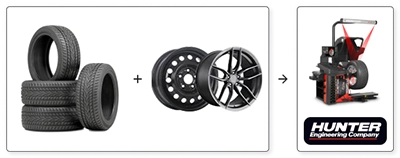Choosing the Right Summer Tires: A Guide to Tire Seasons and Categories in 2024

In Canada, with the arrival of spring, thousands of drivers begin the search for a new set of tires to prepare their vehicles for the upcoming summer. Often, when inquired about the type of tires currently on their vehicles—whether they are summer, all-season, or all-weather tires—many customers find themselves unable to specify. Similarly, when asked if they are seeking all-season, summer, or all-weather tires, the initial reaction from many is surprise, as they had previously believed these terms to be interchangeable. If this is your case, don’t worry, you are not alone!
These terms all sound similar to most drivers across the country, but each category regroups different tire brands and models and knowing what type of tires will best suit your needs will have an impact on the way your vehicle will handle, the durability of your tires as well as your safety on the road.
In this article, we will thoroughly dive into the differences between those three types of tires so that you can have a better understanding of the kind of tires you need and want for your vehicle. This article should definitely help you understand a little better the differences between all those terms and make you a summer-tire expert in no time!
Key Differences Between All-Season, All-Weather and Summer Tires
Through the many tire manufacturers on the market, we find 4 major season designations separating the different tire models, with each season grouping different categories that our experts created to get even more precision on which tire options our customers should look at (more information regarding our tire categories a little further down in the article).
Those 4 season designations are as follows: All-Season, Summer, All-Weather and Winter. Since winter tires are more commonly known, we will briefly go over the details for them and we’ll focus more on the other three seasons.
All-season Tires
All-season tires are the most frequent/common tires found in both the Original Equipment tires as well as the Aftermarket/Replacement tire types. As the name suggests, those tires are made to be driven in mostly all conditions and all year round where permitted*.
All-season tires are designed to provide balanced performance in a variety of driving conditions. They can accomplish this thanks to multiple factors:
Tread Compound
All-season tires are made with a tread compound that offers good performance in both warm and cold temperatures. This compound is typically harder than that used in winter tires, which helps them last longer in warm weather.
Tread Pattern
The tread pattern of all-season tires is a compromise between the patterns found on summer and winter tires. It usually features moderate tread depths and patterns that balance the need for water evacuation (to prevent hydroplaning) and sufficient grip on dry and slightly snowy or icy roads.
Siping and Grooves
All-season tires have sipes (small slits in the tread) and grooves that provide good traction on wet and light snowy roads. These features help in gripping the road better by providing additional biting edges.
It's important to note that while all-season tires are versatile, they are a compromise and do not excel in any one particular area. Drivers who frequently encounter severe winter conditions or very hot climates may benefit from using season-specific tires (winter or summer tires) for those periods.
*Notice for Quebec customers and customers with mandatory winter tire restrictions All-season tires do not have the 3-peak-mountain-snowflake logo on them making them illegal to use in areas where dedicated winter tires are mandatory. Although they are made to handle snow according to the manufacturers, driving them in those areas might result in hefty fines and possible safety concerns as they aren’t made to handle heavy winter conditions like winter tires or even all-weather tires.
Different Categories of All-Season Tires
There are typically 2 categories of tires found through tire models that have all-season capabilities; Touring and Performance.
All-Season Touring Tires
Those tires are a perfect fit for customers seeking great durability, comfort and quietness as well as great fuel efficiency.
They are generally designed to have a longer tread life thanks to their harder compound and balanced tread design, which contributes to slower tread wear in comparison to specialized summer or winter tires.
They are also often designed to offer a comfortable ride with lower road noise, suitable for everyday driving, and they generally offer lower rolling resistance compared to more specialized tires, which can contribute to better fuel efficiency in normal driving conditions.
This combination of tire is the go-to for most sedan/SUV/Comfort vehicles, such as, but not limited to:

All-Season Performance Tires
The other category of tires found in all-season models is the performance type. This combo of tires offers a great balance for customers with luxury/sports sedan/SUV/Coupe vehicles looking for a tire that will offer very good traction on dry surfaces without sacrificing too much durability and comfort.
These tires have a tread design that prioritizes better grip and handling, especially at higher speeds. The tread compounds are often softer than touring tires for better grip, and the patterns may be asymmetric or directional to improve handling and water evacuation.
Finally, all-season performance tires do have some snow capabilities, but they are not designed to perform under heavy winter conditions. They can come in handy when winters arrive a little earlier than expected and there is no place for an appointment before a few days or weeks. Otherwise, we strongly recommend purchasing a set of all-season touring tires for all-year-round use (where allowed) or, even better, dedicated winter tires.
This combination of tire is the go-to for most sedan/SUV/Comfort vehicles, such as, but not limited to:

Here are PMCtire’s top 3 All-Season Tires in the different categories:
Touring
Michelin Defender2
Learn more about the Michelin Defender2
Click here to view Michelin Defender2 sizes and details
Continental PureContact LS
Learn more about the Continental PureContact LS
Click here to view Continental PureContact LS sizes and details
Bridgestone QuietTrack
Learn more about the Bridgestone QuietTrack
Click here to view Bridgestone QuietTrack sizes and details
Performance
Michelin Pilot Sport All Season 4
Learn more about the Michelin Pilot Sport All Season 4
Click here to view Michelin Pilot Sport All Season 4 sizes and details
Continental DWS06+
Learn more about the Continental DWS06+
Click here to view Continental DWS06+ sizes and details
Pirelli PZero All Season Plus
Learn more about the Pirelli PZero All Season Plus
Click here to view Pirelli PZero All Season Plus sizes and details
Summer Tires
Summer tires, also known as ultra-high performance (UHP) tires, are specifically designed for optimal performance in warm weather and dry or wet road conditions.
Tread Compound
Summer tires are made with a softer rubber compound that remains more flexible in high temperatures. This soft compound allows for better grip and traction on warm and hot pavement, providing superior handling and braking performance compared to all-season or all-weather tires in these conditions.
Tread Pattern
The tread pattern of summer tires is generally much less aggressive than that of winter tires. They often have no sipes (small slits) at all as they are not designed for snow and ice. The tread patterns are optimized to increase the contact area with the road, which enhances grip and handling, especially during cornering, accelerating, and braking.
Water Evacuation
While they lack the sipes needed for snowy conditions as mentioned, summer tires still have adequate tread designs to handle wet roads thanks to linear grooves around the circumference of the tire. They are designed to effectively channel water away from the tire's footprint to reduce the risk of hydroplaning.
High-Speed Stability
Summer tires often have a stiffer construction compared to all-season tires. This stiffer design, combined with the specialized tread patterns, provides better stability and responsiveness at higher speeds and cornering. They are often the preferred choice for sports cars and performance driving.
Temperature Range
Summer tires perform best in warm and hot climates. They are not suitable for cold weather, as the rubber compound can become too hard in low temperatures (below 7°C), leading to reduced traction and a higher risk of tire damage
Wear Rate
The softer compound of summer tires can lead to faster tread wear compared to all-season tires, especially if driven aggressively or in conditions they're not designed for (like cold weather).
Different Categories of Summer Tires
There are 2 categories of tires for strictly summer tires: Ultra-High Performance (UHP) and Track tires. Both these categories are made to offer excellent grip on dry surfaces, excellent handling and great cornering capabilities. The main differences between them is that UHP tires offer a bit of a compromise between performance tires that can be used on the roads and on a daily basis (in good summer conditions), whereas track tires will be much more focused on racing events and reduce timing on the track as much as possible, making them a lot less durable than UHP tires and dangerous to use on a daily basis if the conditions aren’t optimal (rain, temperatures below 7°C, etc.).
Summer tires are the go-to for customers looking to maximize their vehicle performance, such as, but not limited to:

Here are PMCtire’s top 3 Summer Tires in the different categories:
UHP
Michelin Pilot Sport 4 S
Learn more about the Michelin Pilot Sport 4 S
Click here to view Michelin Pilot Sport 4 S sizes and details
Continental ExtremeContact Sport 02
Learn more about the Continental ExtremeContact Sport 02
Click here to view Continental ExtremeContact Sport 02 sizes and details
Bridgestone Potenza Sport
Learn more about the Bridgestone Potenza Sport
Click here to view Bridgestone Potenza Sport sizes and details
Track
Michelin Pilot Sport Cup 2
Learn more about the Michelin Pilot Sport Cup 2
Click here to view Michelin Pilot Sport Cup 2 sizes and details
Hankook Ventus RS4
Learn more about the Hankook Ventus RS4
Click here to view Hankook Ventus RS4 sizes and details
Bridgestone Potenza RE-71RS
Learn more about the Bridgestone Potenza RE-71RS
Click here to view Bridgestone Potenza RE-71RS sizes and details
In summary, summer tires are ideal for high-performance vehicles and are best suited for warm climates and dry or wet road conditions. They offer enhanced grip, handling, and stability in these conditions but are not suitable for winter weather and can wear more quickly than all-season tires.
Here is a graph representing the 4 tire categories described above and their position regarding durability and traction/performance/handling:

All-Weather Tires
Over the past few years, all-weather tires have been more and more popular among manufacturers as well as customers. Like all-season tires, all-weather tires are made to be driven all-year-round regardless of weather conditions outside. They are made to provide a balanced-performance through several conditions (dry, hot surfaces to rainy or snowy conditions).
The main difference is that all-weather tires do have the 3-peak-mountain-snowflake logo on their sidewalls, just like dedicated winter tires, meaning they are legal in areas that require the mountain logo (as is the case in Quebec) for winter driving.

The mountain logo does not only make them legal to be driven in restricted areas, it also means that the tires underwent standardized testings that measure its performance in snow conditions. This test is typically conducted by tire manufacturers or independent testing facilities.
In order to get approval, the tire must demonstrate a certain level of traction in snow compared to a reference tire. The testing involves a traction test on packed snow, where the tire's ability to accelerate is measured. The tire must achieve at least 110% of the traction of the reference tire to pass.
All-weather tires are capable of achieving great performance no matter what the conditions are thanks to different technologies such as:
Adaptive Rubber Compound
All-weather tires use a unique rubber compound that remains flexible and maintains grip in a broader range of temperatures compared to typical all-season tires. This compound does not harden as much as standard all-season tires in cold temperatures, providing better traction in winter conditions, yet it is durable enough to withstand summer heat.
Intermediate Tread Pattern
The tread pattern of all-weather tires is a hybrid between those of winter and all-season tires. It includes moderate siping (small slits in the tread blocks) for enhanced grip on ice and snow, and wider grooves for effective water evacuation to reduce hydroplaning in wet conditions.
Blocky Tread Elements
These tires often feature blocky tread elements, enhancing their ability to bite into snow and improve traction.
Balanced Tread Depth
All-weather tires typically have a deeper tread depth than summer tires, which helps in managing snow and slush, yet not as deep as dedicated winter tires.
Increased Sipe Density
The higher density of sipes (compared to regular all-season tires) provides additional biting edges for better grip on icy and snowy roads.
Temperature Versatility
Broad Temperature Range Performance All-weather tires are engineered to perform reliably in a wide temperature range, from hot summer days to cold winter nights.
Durability
While offering better winter performance than standard all-season tires, all-weather tires also tend to have a longer lifespan than dedicated winter tires when used year-round.
All-weather tires are mostly manufactured in 3 tire categories: Touring (for most cars and SUVs) as well as All-Terrain and Highway-Terrain (for pick-up trucks or commercial vehicles). They are an excellent choice for drivers who experience a range of weather conditions but don’t encounter severe winter weather regularly enough to warrant a separate set of winter or don’t feel the need to maximize the performance of their vehicle through summer tires. They offer a good balance between the dry and wet performance of all-season tires and the cold weather capabilities of winter tires.
Here are PMCtire’s top 3 All-Weather tires in the most popular categories:
Touring
Michelin CrossClimate2
Learn more about the Michelin CrossClimate2
Click here to view Michelin CrossClimate2 sizes and details
Bridgestone WeatherPeak
Learn more about the Bridgestone WeatherPeak
Click here to view Bridgestone WeatherPeak sizes and details
Goodyear Assurance WeatherReady
Learn more about the Goodyear Assurance WeatherReady
Click here to view Goodyear Assurance WeatherReady sizes and details
All Terrain
BFGoodrich All-Terrain T/A KO2
Learn more about the BFGoodrich All-Terrain T/A KO2
Click here to view BFGoodrich All-Terrain T/A KO2 sizes and details
Goodyear Wrangler Duratrac
Learn more about the Goodyear Wrangler Duratrac
Click here to view Goodyear Wrangler Duratrac sizes and details
Toyo Open Country A/T III
Learn more about the Toyo Open Country A/T III
Click here to view Toyo Open Country A/T III sizes and details
Winter Tires
When it comes to winter tires, as mentioned in the introduction, there is much less to talk about. Obviously, winter tires are made to perform in severe weather conditions during the winter season.
There are 2 categories of winter tires: Touring and Performance. Just like all-season tires, the Touring version are made to provide comfortable, quiet rides with great traction in the snow, whereas Performance winter tires are tires that perform well in the snow too, but they are designed for customers with sports vehicles that are looking to keep a pretty good handling and sporty feeling even during the winter months.
Here are PMCtire’s top 3 Winter Tires in the different categories:
Touring
Michelin X-Ice Snow
Learn more about the Michelin X-Ice Snow
Click here to view Michelin X-Ice Snow sizes and details
Continental VikingContact 7
Learn more about the Continental VikingContact 7
Click here to view Continental VikingContact 7 sizes and details
Bridgestone Blizzak WS90
Learn more about the Bridgestone Blizzak WS90
Click here to view Bridgestone Blizzak WS90 sizes and details
Performance
Michelin Pilot Alpin 5
Learn more about the Michelin Pilot Alpin 5
Click here to view Michelin Pilot Alpin 5 sizes and details
Pirelli Winter Sottozero 3
Learn more about the Pirelli Winter Sottozero 3
Click here to view Pirelli Winter Sottozero 3 sizes and details
Bridgestone Blizzak LM001
Learn more about the Bridgestone Blizzak LM001
Click here to view Bridgestone Blizzak LM001 sizes and details
Shopping your new set of summer tires at PMCtire
Choosing the right tire that will meet your demands as a consumer as well as your vehicle’s might be challenging. This is why we created this system of tire categories and seasonality, to help customers get what they really need by themselves.
Now that we’ve discussed the differences between the different types of seasons available on the market of tires as well as the different categories defined by our team of experts, you should have a better idea of the tires you want to purchase ahead of the tire changing season.
You can easily navigate through the filters located on the left-hand side of the website on a desktop or by clicking the “Filters” button on a mobile device after entering your vehicle or tire dimensions in order to narrow down the number of results and focus on the models that will suit your needs the most!

Don’t hesitate to reach out to our team of experts who will be happy to answer any question you might have and find the best tire that suits your needs!
Dominic Vaillancourt
Automotive expert & Spokesperson


